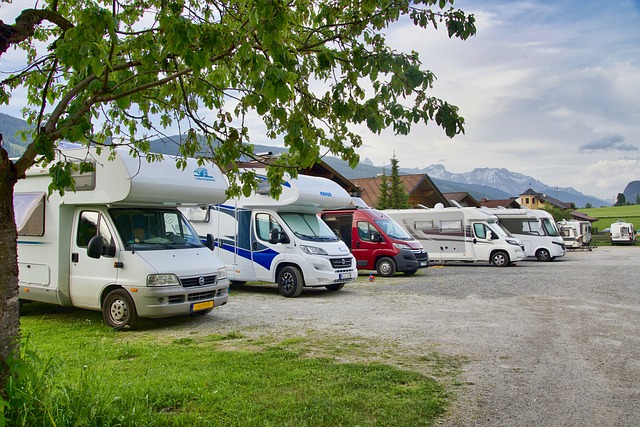Embarking on an RV travel adventure requires a thorough understanding of your vehicle's dimensions and weight, as these factors significantly influence its handling, braking, and stability. It's crucial to adhere to RV travel tips that emphasize pre-trip safety inspections, including checking the brake system, tires, lights, engine condition, and ensuring proper load distribution and weight capacities align with the manufacturer's guidelines. RVers should also utilize GPS systems designed for large vehicles, plan routes with lower speed limits and ample shoulders, especially in unfamiliar areas, and be mindful of height restrictions at overhead structures to avoid accidents. Awareness of road signs, blind spots, weather forecasts, and vehicle limitations is vital for a safe journey. Additionally, being prepared for emergencies by establishing and rehearsing tailored emergency procedures, knowing the RV's layout, and locating safety equipment quickly are essential RV travel tips for ensuring readiness in critical situations. Regular drills and staying informed about weather conditions enhance confidence and security during your RV travel adventure. Following these RV travel tips can greatly contribute to a safer and more enjoyable trip.
Embarking on an RV journey offers a blend of adventure and comfort, inviting explorers to traverse diverse landscapes with the conveniences of home in tow. To ensure your travels are safe and memorable, this article provides comprehensive RV travel tips tailored for seasoned road warriors and newcomers alike. From grasping your RV’s dimensions and limitations to conducting thorough pre-trip safety inspections, and planning routes with precision, the guidance offered will enhance your awareness and preparedness on the open road. Additionally, understanding how to respond to incidents and having emergency procedures at the ready can make the difference between a hiccup and a full-blown predicament. By integrating these RV travel tips into your upcoming trips, you’ll navigate confidently, savoring each destination with peace of mind.
- Understanding Your RV's Dimensions and Limitations
- Pre-Trip Safety Inspections for RV Drivers
- Navigating Roadways with an RV: Route Planning and Awareness Techniques
- Incident Response and Emergency Procedures in RV Travel
Understanding Your RV's Dimensions and Limitations

When embarking on an RV travel adventure, it’s imperative to have a comprehensive understanding of your vehicle’s dimensions and limitations. This knowledge is crucial for navigating safely through various terrains and road conditions. The size and weight of your RV will influence how it handles turns, its stopping distance, and its overall stability on the road. RV travel tips often emphasize the importance of knowing the length, height, and width of your RV to avoid potential accidents caused by obstacles like low-hanging branches, tight turns, or narrow lanes. Additionally, understanding the weight distribution and capacity can prevent overloading, which not only is a safety hazard but also can lead to costly fines and vehicle damage. Always consult the RV’s owner manual for specific details on its capabilities and restrictions. By familiarizing yourself with these parameters, you can adjust your driving style accordingly, ensuring a safer journey and reducing the likelihood of mishaps that could spoil your travel experience. Keep in mind that driving an RV is notably different from operating a standard vehicle; thus, practicing in an open area can provide valuable insights into how your RV will react under various maneuvers, allowing you to confidently navigate your home on wheels through the scenic routes and highways with greater ease and safety.
Pre-Trip Safety Inspections for RV Drivers

When embarking on an RV travel adventure, conducting thorough pre-trip safety inspections is paramount to prevent accidents and ensure a safe journey. RV drivers should perform comprehensive checks on their vehicle’s systems, including brakes, tires, lights, and engine. Verify that the brake system functions correctly by checking for leaks, ensuring the pads or shoes are in good condition, and testing the brakes at varying speeds. Tires should be inspected for proper inflation, tread wear, and any signs of damage or irregularities. It’s equally important to examine all exterior lights and turn signals, cleaning lenses if necessary for optimal visibility. Additionally, the battery, battery connection, and electrical systems should be in working order, with no loose wires that could pose a hazard. RV travel tips often emphasize these pre-trip safety inspections as they are critical in identifying potential issues before they lead to accidents on the road.
Safety inspections extend beyond the vehicle’s immediate systems; drivers must also consider load distribution and weight capacities. Ensure that cargo is evenly distributed, and the RV is not overloaded, as this can affect handling and braking. It’s advisable to double-check the owner’s manual for specific weight recommendations, including those for the tow vehicle if applicable. Proper maintenance of the RV’s propane system, including gas leaks, is also crucial, given the flammable nature of propane. Lastly, RV drivers should familiarize themselves with nearby service stations and emergency contacts along their route, creating a plan for timely maintenance and assistance should they encounter issues during their travels. Adhering to these RV travel tips for pre-trip safety inspections will significantly reduce the risk of accidents and ensure a smoother, more enjoyable journey.
Navigating Roadways with an RV: Route Planning and Awareness Techniques

When embarking on RV travel, careful route planning is paramount for a safe and enjoyable journey. To ensure your RV trip proceeds without incident, it’s essential to select roads that accommodate your vehicle’s size and weight. Opt for routes with lower speed limits and wide shoulders for safer maneuvering, especially in unfamiliar areas. Utilize GPS systems designed for RVs, which provide routing options tailored to large vehicles, avoiding low clearance bridges and narrow lanes. Always check the height restrictions on overhead structures along your route, as bridges and tunnels may have limitations that could lead to costly and dangerous accidents.
Awareness of your surroundings is crucial while driving an RV. Keep a watchful eye for road signs indicating weight and height restrictions, as well as for any sharp turns or steep gradients. Be mindful of the RV’s blind spots and drive at speeds that allow you to react appropriately to changing conditions. It’s also wise to stay updated on weather forecasts, as poor visibility or adverse weather can drastically affect your vehicle’s handling and safety. By integrating these RV travel tips into your journey, you’ll enhance your route planning and situational awareness, significantly reducing the risk of accidents on the road.
Incident Response and Emergency Procedures in RV Travel

When embarking on RV travel, being prepared for emergencies is crucial. Incident response and emergency procedures are vital components of safe RV travel. Every RVer should have a well-practiced plan in place for various scenarios that may arise during their journey. This includes understanding the layout of your RV, knowing where the fire extinguishers, first aid kit, and emergency supplies are located, and ensuring everyone on board is familiar with these resources. In the event of an incident, such as a collision or a medical emergency, it’s imperative to remain calm and act swiftly. For instance, if a fire breaks out, immediate action should be taken to extinguish it using the appropriate fire extinguisher, while also alerting occupants and calling emergency services if necessary. RV travel tips often emphasize having multiple escape routes planned, as the size and weight of an RV can complicate evacuation compared to a standard vehicle. Regular drills for different emergencies, including both day and night scenarios, help RVers stay sharp and responsive in stressful situations. Additionally, staying updated on weather conditions and having a reliable communication device are part of responsible RV travel tips, as they enable timely responses to severe weather events or other hazardous conditions that may impact your safety on the road. By prioritizing preparedness and practicing emergency procedures, RVers can navigate their travels with greater confidence and peace of mind.
When embarking on RV travel, it’s crucial to operate with heightened awareness and adherence to safety protocols. By understanding your RV’s dimensions and limitations, conducting thorough pre-trip safety inspections, strategically planning your routes, and preparing for emergencies, you can significantly reduce the risk of accidents. The insights provided in this article serve as a comprehensive guide to safe RV driving, ensuring that your journey is as enjoyable and incident-free as possible. With these RV travel tips in hand, the open road awaits with adventure and discovery, all within the comfort and safety of your home on wheels. Remember to always stay vigilant and follow best practices for RV handling to maintain your safety and the safety of others sharing the road. Happy travels!
